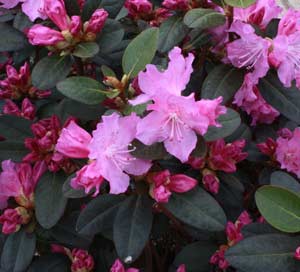Rhododendrons – Pruning, Winter Care and Fertilizing
 These plants should be pruned in late spring, after they have flowered. However, very little pruning is required. Remove crossing or crowded side branches back to a main branch. Removal of spent flower heads is important for promoting next years bloom as well as a good overall shape. Spent flower heads should be taken back to a side branch.
These plants should be pruned in late spring, after they have flowered. However, very little pruning is required. Remove crossing or crowded side branches back to a main branch. Removal of spent flower heads is important for promoting next years bloom as well as a good overall shape. Spent flower heads should be taken back to a side branch.
Pay special attention to this plants fertilizing and winter care needs. This plant grows and develops best in acidic soil. Most of the soil, all of the rainwater and all of the ground water in southeastern Wisconsin is basic or alkaline. Therefore, for some plants to thrive, they need to have special care.
Initially, the soil the plant is installed into should be amended to make it more acidic and to increase the amount of organic matter in the soil. Over time, the soils acidity should be supplemented with an acid-based fertilizer. A liquid fertilizer, Miracid works well. This liquid fertilizer is mixed with water and applied the same as you would water the plant (see product for specific details). This type of fertilization should be done three or four times per year, starting in April and ending by the mid-July. Soil can also be acidified with soil sulfur, aluminum sulfate or cotton seed meal, however, these products will not fertilize the plant. Mulch is also important to acid loving plants. A 2-4″ thickness of bark or needle mulch should surround the plant at least as far out as its drip line.
PJM type rhododendrons in most years will not require extra winter care. For the other years protection from the winter sun and wind is the most important measure you can take. This is best accomplished by wrapping the plant in burlap, or enclosing it in a burlap tent. This form of protection will keep the wind and sun off, but will not cut off air flow or trap heat, which can be harmful to the plant. A burlap tent is made by setting three wooden stakes into the ground around the plant and stapling burlap to it on all three sides. The top of this tee-pee like structure should be left open. Non PJM rhododendrons do require extra protection on a regular basis.
These plants should be mulched at the base with 3-4″ of compost, bark or straw. Add winter protection for this plant in late November and remove it in mid April. Watering in late fall is very important for the winter health of any evergreen and should be done to young plants every year in early November. Even more mature plants can benefit from late season waterings, especially after a dry fall season.
